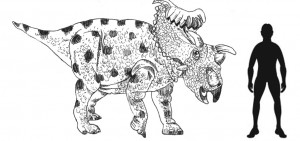2010 – What a Good Year for Ceratopsians
Horned Dinosaurs Hog the Limelight in 2010
2010 will be remembered by many palaeontologists as the “Year of the Ceratopsian”. For the Chinese, in their traditional calendar, 2010 may well be the year of the tiger but for palaeontologists, the last twelve months seem to have been dominated by new discoveries, new theories and new insights into all things Marginocephalian. We even have had the suggestion that some ceratopsians took to the water, as with the recent discovery in South Korea of Koreaceratops.
A Scale Drawing of Koreaceratops
Picture credit: Everything Dinosaur.
Year of the Ceratopsian
Following on from the extensive re-assessment of the ceratopsian family undertaken at the Royal Tyrrell Museum in Alberta, Canada (ceratopsian symposium), a whole host of new genera have been announced, not just from the United States, as in the case of Medusaceratops lokii, but also from elsewhere in the world.
Earlier this year, the discovery of a large, Chinese horned dinosaur was announced Sinoceratops zhuchengensis and Mexico had its first ceratopsian dinosaur discovery published – Coahuilaceratops magnacuerna. To add to the new discoveries, there were also a number of new studies undertaken on existing fossil material, such as the research into whether Triceratops, perhaps the most famous of all the Late Cretaceous horned dinosaurs was actually a valid genus or not.
One of the puzzling things that has emerged recently, is the amazing diversity of the horns, bumps and lumps that ceratopsian genera possessed. The facial characteristics of these large ornithischian herbivores were extensively varied. The diversity seen in the fossil record prompted a study by palaeontologists Kevin Padian (University of California) and Jack Horner of the Museum of the Rockies.
These scientists examined the array of horns, frills, neck shields and other facial ornamentation and concluded that, in contrast to earlier beliefs they did not appear to have evolved for combat purposes such as defence against predators.
The team concluded that if defence was the primary function of such structures then the arrangement of the horns and crests could be expected to be similar across different genera. There would have been an optimum pattern for defence evolved to see off the large theropods of the Cretaceous. However, the variation seen in the ceratopsian fossil record, whether the centrosaurines or chasmosaurines are studied, suggests that fending of predators was not the sole factor driving the evolution of such structures.
Horner and Padian state that something as simple as species recognition could have played a significant role in the evolution of the myriad forms of ceratopsian “head gear”. Perhaps these horned dinosaurs, from the single horned Monoclonius crassus to the multi-horned dinosaur described by a member of Everything Dinosaur as a “walking Swiss army knife” – Kosmoceratops richardsoni, were nothing more than a lot of show offs.
A Scale Drawing of Kosmoceratops richardsoni
Picture credit: Everything Dinosaur.
The drawings used in this article represent different horned dinosaurs from the CollectA range of models: CollectA Prehistoric Life Age of Dinosaurs Models.



